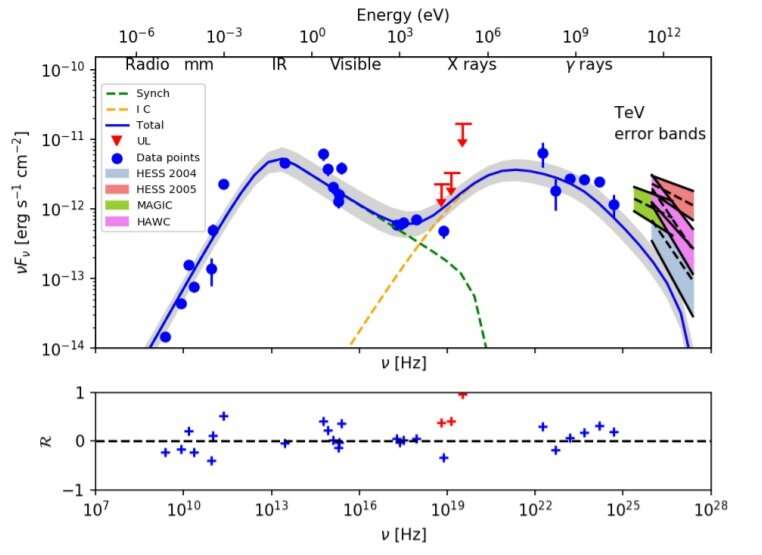December 28, 2021 report
Research inspects very high energy emission from Messier 87

An international team of astronomers has investigated a very high energy (VHE) emission from the radio galaxy Messier 87. Results of the study, published December 16 on arXiv.org, could help us better understand the nature of M87 and the processes responsible for VHE emission from this source.
Radio galaxies (RDGs) emit huge amounts of radio waves from their central cores. Black holes at the centers of these galaxies accrete gas and dust, generating high-energy jets visible in radio wavelengths, which accelerate electrically charged particles to high velocities.
Located some 53.5 million light years away, Messier 87 (or M87, also known as Virgo A) is the central dominant galaxy of the Virgo Cluster. It is classified as a giant Fanaroff-Riley I radio galaxy, has a diameter of about 980,000 light years, and its dynamical mass is estimated to be some 15 trillion solar masses. One of the most noticeable features is its prominent jet with complex structures like knots and diffuse emission, apparent superluminal motion, showcasing also complex variability.
M87 was the first radio galaxy detected at VHE and exhibits a complex behavior at very high energies with a rapid variability during flaring states. However, the mechanism responsible for the VHE emission in this galaxy. Therefore, a group of researchers led by Fernando Urena-Mena of the National Institute of Astrophysics, Optics and Electronics in Puebla, Mexico, decided to explore this topic by analysing the available data from the Imaging Air Cherenkov Telescopes (IACTs) and the High Altitude Water Cherenkov (HAWC) Observatory.
"The main goal of this work is comparing the VHE emission of the RDG M87 observed by IACTs during specific epochs (including the 2005 flare) with the long term quiescent/average emission provided by continuous observation by the HAWC observatory from 2014 to 2019. We used a lepto-hadronic model, which combines SSC [Synchrotron Self Compton] and photo-hadronic scenarios, to explain this emission," the astronomers wrote in the paper.
In order to explain the VHE emission of M87, the team fitted a broadband spectral energy distribution (SED) of this galaxy with a lepto-hadronic model. When it comes to the emission from radio to GeV gamma rays, it was modeled by them with an SSC scenario.
The results show that the lepto-hadronic model is able to explain the quiescent VHE emission from M87 that was detected by HAWC and other observing facilities. The model can explain the so-called orphan flares of this galaxy, which are only detected at VHE bands. Those flares would be produced by changes in the proton energy distribution.
The researchers also estimated the proton energy distribution index with the four VHE data sets. This parameter was found to be at a level of 2.8. The result is consistent with a study conducted in 2016 where a similar lepto-hadronic model was used.
The astronomers noted that further monitoring of M87 with HAWC will be necessary to further explore the origin of its VHE emission. They added that better understanding of M87's very high energy emission could be crucial in order to improve our general knowledge of radio galaxies and their properties.
More information: Study of the Very High Energy emission of M87 through its broadband spectral energy distribution, arXiv:2112.09179 [astro-ph.HE] arxiv.org/abs/2112.09179
© 2021 Science X Network


















